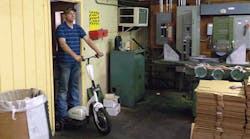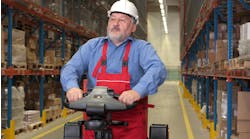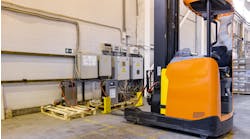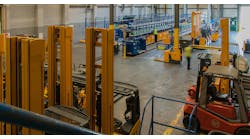With the slow economic rebound and 2-3% predicted growth in 2013, large manufacturing plants and distribution facilities are looking for some efficiency wins. Strategies can be as simple as using small electric scooters to shave miles of unproductive walking time. Other benefits of using these one-person vehicles include reducing wear and tear on employee's bodies and preventing the misappropriation of material handling equipment as a means of transportation.
See Also: Warehousing & Distribution Management
With the average walking speed estimated at 3.1 mph, even a distance of a half a mile and back, several times a day, can eat up 4-5 hours each week in walking time. Multiply that by several employees and multiple shifts and the production loss adds up quickly.
Excessive daily walking also takes a toll in wear and tear on employees. Even healthy personnel that travel daily throughout the facility can become fatigued, which can lead to mistakes, injuries or lost productivity. This is exacerbated for older employees, those that have difficulty walking, and those with disabilities.
Electric scooters can help fill a transportation gap inside the four walls. A small, one-person electric scooter costs between 20-30% of the price of electric utility carts (golf carts), Segways, T3s, ATVs and other personnel movers.
Industrial electric scooters can achieve speeds up to 16 mph, to distances of 25 miles on a single, ten cent charge. When not in use the scooters keep their charge for weeks, and the batteries operate for years without maintenance or replacements.
As opposed to golf carts and lift trucks, electric scooters are small and fit easily through standard doorways and narrow aisles found in many of today's large warehouses. Scooters can reduce damage to warehousing equipment and facilities, as well as decrease injuries to personnel. They are also quiet and operate without emissions.
Typical tasks for scooters in a plant or warehouse include supervisor rounds, picking small items from inventory, maintenance, and conducting inventory counts and meter readings, to name a few.
Hallmark's Subterranean DC
Recently, general manager Lona Smith decided to invest in five electric scooters for use at Hallmark's 300,000 square foot distribution center located at SubTropolis, the largest underground business complex in the world.
The manmade limestone cave in Kansas City, Mo., contains almost seven miles of illuminated, paved roads and several miles of railroad track.
Within this complex, 5 million square feet are dedicated to housing approximately 50 different tenants, including Hallmark Retail, which ships gift products to hundreds of corporately-owned Gold Crown Hallmark stores throughout the United States.
After some investigation, Smith decided on 3-wheeled electric scooters (GoPets from Mighty Lift Inc.). Hallmark employees and facility managers use the scooters for everything from supervision to researching inventory issues, identifying automation production issues, transporting paperwork and moving from one place to another.
Smith estimates that each scooter saves employees up to 10 miles per day total in walking over the course of the company's daily three-shift operation. Smith uses a scooter herself to conduct site surveys throughout the facility.
"It definitely frees up employee time they would have spent just literally walking from one location back to their office area to do other, more meaningful functions," says Smith.
In search of a solution to cover the vast distances at SubTropolis, Smith initially approved the purchase of a golf cart. However, she says it required a lot of maintenance, including frequent battery changes.
"For us, it made a lot of sense: one golf cart or five scooters," says Smith. She adds that it is likely they will purchase more electric 3-wheeled scooters in the future.
No Segway
For Doug Buehl, risk manager at metal component manufacturer Clow Stamping, trips from one end of the company's 250,387 square foot facility in Merrifield, Minn., of a quarter mile each way stimulated his desire for a better solution.
Initially, Buehl considered the Segway. The Segway comes the closest to meeting the design functionality of an electric scooter, though at approximately three times the cost.
However, concerns over the safety of the Segway, which are two-wheeled devices that require balance and leaning of the body to operate, along with the amount of time required to master this technique, deterred him.
"The Segway cost more and seemed a little less safe," says Buehl, adding that the 3-wheeled scooter he decided to order took only seconds for him and his staff to master.
After purchasing a scooter as a trial run, Clow Stamping purchased three additional scooters, to be shared among personnel operating in each of three 8-hour shifts. The scooters are used for shift supervision, maintenance, and transportation of overnight shipping packages from the delivery area using the trailer cart accessory.
Buehl estimates that one key shift supervisor was walking over six miles each day, at a loss of two hours per shift. He adds that the supervisor is one of many of the company's current 400+ employees that have been with the company for 20-30 years, which means they are in their 50s and 60s.
Transporting Heavy Loads
For Richard Polasek, production engineer at RPR Products, performing maintenance at a large facility while hauling 40 lbs. of tools necessitated an electric vehicle. Located in Houston, Texas, RPR Products is a supplier of metal jacketing and industrial siding.
Among Polasek's primary responsibilities is maintaining manufacturing equipment, along with other projects throughout the facility. He estimates he was walking several miles a day carrying his tool bag.
"I was walking back and forth from building to building with a 40-pound bag and it was a hassle," explains Polasek. "I can't tell you how much time I wasted just walking."
When no personnel movers are available, the "solution" often becomes usurping material handling equipment like forklifts and electric pallet jacks to transport personnel. However, these large, expensive vehicles are not designed for that purpose and using them can be dangerous to both warehouse personnel as well as the warehouse itself.
Polasek admits that he was frequently caught driving a forklift.
"There would be some days where I wasn't about to try to walk, especially toward the end of the day when my legs were so tired," says Polasek. "So I would grab a forklift."
After a discussion with the company's forklift distributor, Polasek decided to purchase an electric scooter.
Polasek estimates he saves several hours per week in walking time. Among the benefits he enjoys is being able to drive the scooter between pieces of manufacturing equipment for maintenance—spaces that are only a few feet wide.
When Polasek was without the scooter for a short period of time due to a flat tire, he noticed a difference in productivity, as well as the effect on his body.
"I was drained by the end of each day because I had to walk everywhere again," says Polasek.



